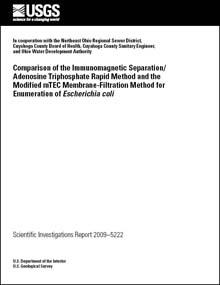Scientific Investigations Report 2009–5222
ABSTRACT
Water quality at beaches is monitored for fecal indicator bacteria by traditional, culture-based methods that can take 18 to 24 hours to obtain results. A rapid detection method that provides estimated concentrations of fecal indicator bacteria within 1 hour from the start of sample processing would allow beach managers to post advisories or close the beach when the conditions are actually considered unsafe instead of a day later, when conditions may have changed. A rapid method that couples immunomagnetic separation with adenosine triphosphate detection (IMS/ATP rapid method) was evaluated through monitoring of Escherichia coli (E. coli) at three Lake Erie beaches in Ohio (Edgewater and Villa Angela in Cleveland and Huntington in Bay Village). Beach water samples were collected between 4 and 5 days per week during the recreational seasons (May through September) of 2006 and 2007. Composite samples were created in the lab from two point samples collected at each beach and were shown to be comparable substitutes for analysis of two individual samples. E. coli concentrations in composite samples, as determined by the culture-based method, ranged from 4 to 24,000 colony-forming units per 100 milliliters during this study across all beaches. Turbidity also was measured for each sample and ranged from 0.8 to 260 neophelometric turbidity ratio units. Environmental variables were noted at the time of sampling, including number of birds at the beach and wave height. Rainfall amounts were measured at National Weather Service stations at local airports. Turbidity, rainfall, and wave height were significantly related to the culture-based method results each year and for both years combined at each beach. The number of birds at the beach was significantly related to the culture-based method results only at Edgewater during 2006 and during both years combined. Results of the IMS/ATP method were compared to results of the culture-based method for samples by year for each beach. The IMS/ATP method underwent several changes and refinements during the first year, including changes in reagents and antibodies and alterations to the method protocol. Because of the changes in the method, results from the two years of study could not be combined. Kendall’s tau correlation coefficients for relations between the IMS/ATP and culture-based methods were significant except for samples collected during 2006 at Edgewater and for samples collected during 2007 at Villa Angela. Further, relations were stronger for samples collected in 2006 than for those collected in 2007, except at Edgewater where the reverse was observed. The 2007 dataset was examined to identify possible reasons for the observed difference in significance of relations by year. By dividing the 2007 data set into groups as a function of sampling date, relations (Kendall’s tau) between methods were observed to be stronger for samples collected earlier in the season than for those collected later in the season. At Edgewater and Villa Angela, there were more birds at the beach at time of sampling later in the season compared to earlier in the season. (The number of birds was not examined at Huntington.) Also, more wet days (when rainfall during the 24 hours prior to sampling was greater than 0.05 inch) were sampled later in the season compared to earlier in the season. Differences in the dominant fecal source may explain the change in the relations between the culture-based and IMS/ATP methods. |
Posted October 2009 For additional information contact: Part or all of this report is presented in Portable Document Format (PDF); the latest version of Adobe Reader or similar software is required to view it. Download the latest version of Adobe Reader, free of charge. |
Brady, A.M.G., Bushon, R.N., and Bertke, E.E., 2009, Comparison of the immunomagnetic separation/adenosine triphosphate rapid method and the modified mTEC membrane-filtration method for enumeration of Escherichia coli: U.S. Geolgogical Survey Scientific Investigations Report 2009–5222, 21 p.
Abstract
Introduction
Purpose and Scope
Study Area
Methods of Study
Results
Future Steps
Summary and Conclusions
References Cited